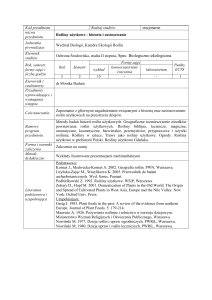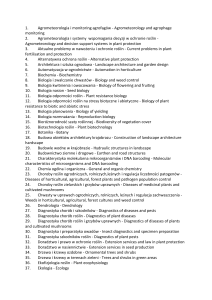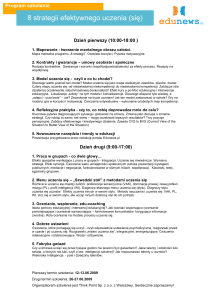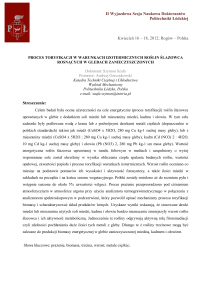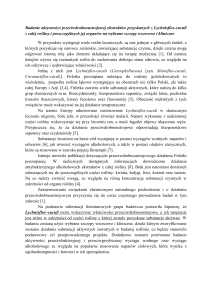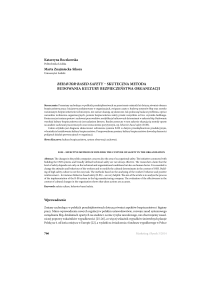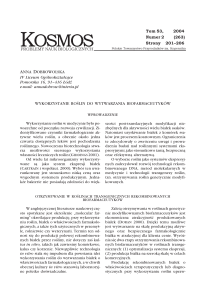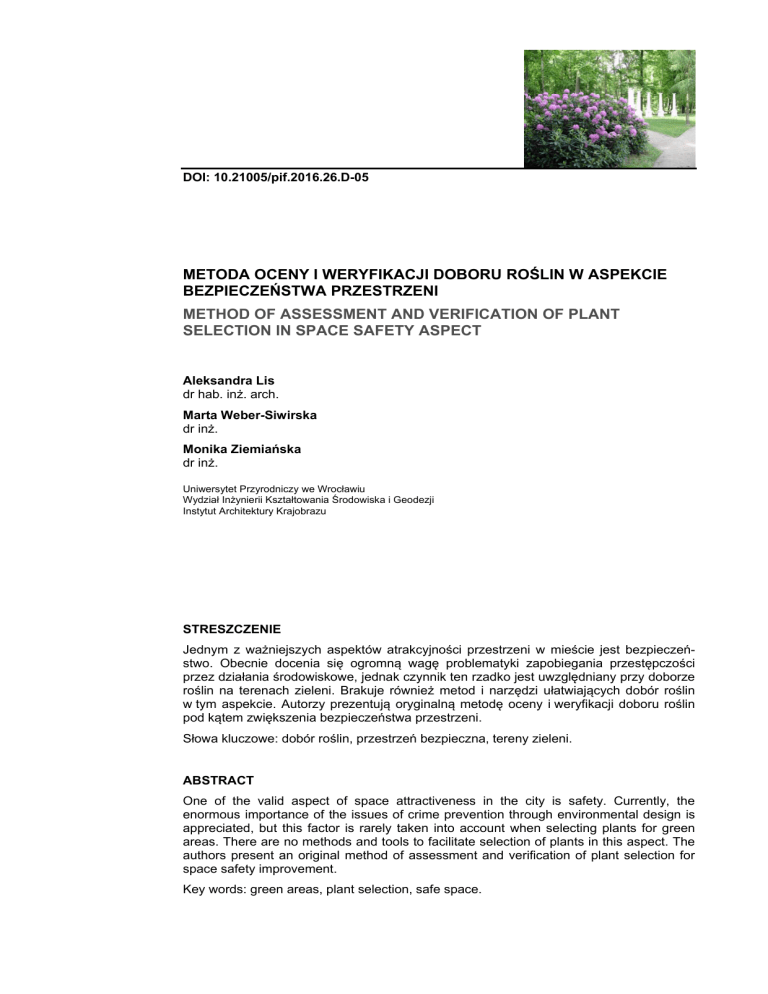
DOI: 10.21005/pif.2016.26.D-05
METODA OCENY I WERYFIKACJI DOBORU ROŚLIN W ASPEKCIE
BEZPIECZEŃSTWA PRZESTRZENI
METHOD OF ASSESSMENT AND VERIFICATION OF PLANT
SELECTION IN SPACE SAFETY ASPECT
Aleksandra Lis
dr hab. inż. arch.
Marta Weber-Siwirska
dr inż.
Monika Ziemiańska
dr inż.
Uniwersytet Przyrodniczy we Wrocławiu
Wydział Inżynierii Kształtowania Środowiska i Geodezji
Instytut Architektury Krajobrazu
STRESZCZENIE
Jednym z ważniejszych aspektów atrakcyjności przestrzeni w mieście jest bezpieczeństwo. Obecnie docenia się ogromną wagę problematyki zapobiegania przestępczości
przez działania środowiskowe, jednak czynnik ten rzadko jest uwzględniany przy doborze
roślin na terenach zieleni. Brakuje również metod i narzędzi ułatwiających dobór roślin
w tym aspekcie. Autorzy prezentują oryginalną metodę oceny i weryfikacji doboru roślin
pod kątem zwiększenia bezpieczeństwa przestrzeni.
Słowa kluczowe: dobór roślin, przestrzeń bezpieczna, tereny zieleni.
ABSTRACT
One of the valid aspect of space attractiveness in the city is safety. Currently, the
enormous importance of the issues of crime prevention through environmental design is
appreciated, but this factor is rarely taken into account when selecting plants for green
areas. There are no methods and tools to facilitate selection of plants in this aspect. The
authors present an original method of assessment and verification of plant selection for
space safety improvement.
Key words: green areas, plant selection, safe space.
214
s p a c e
&
FORM
|
p r z e s t r z e ń
i
FORMa ‘26_2016
1. WSTĘP
Mówiąc o atrakcyjności form krajobrazowych, w tym terenów zieleni w mieście, najczęściej mamy na myśli ich cechy estetyczne, poznawcze i użytkowe. Takie tradycyjnie przyjęte traktowanie tego pojęcia wydaje się dziś niewystarczające. Atrakcyjność jest pojęciem subiektywnym odnoszącym się do potrzeb grup lub jednostek. Obiekt jest tym bardziej atrakcyjny, w im większym stopniu zaspokoi owe potrzeby – zwłaszcza potrzeby
szczególnie dla człowieka ważne. Do takich należy potrzeba bezpieczeństwa.
Miasto staje się miejscem coraz mniej bezpiecznym dla mieszkańców, a lęk towarzyszący przebywaniu w jego przestrzeni nasila się. Prowadzi on nie tylko do obniżenia jakości
życia [28, 29], ale też odgrywa kluczową rolę w kształtowaniu zachowań i odczuć towarzyszących przebywaniu w przestrzeni – niegdyś przyjaznej, inspirującej, kształtującej
więzi społeczne i relacje z miejscem. Tradycyjne badania nad przestępczością i lękiem
przed przestępczością skupiały się przede wszystkim na aspektach społecznych, takich
jak motywy sprawców. Pomimo że pierwsze mapy przestępczości wraz z analizami pojawiły się już w XIX w. – zostały sporządzone w 1833 r. przez francuskiego adwokata i dotyczyły przestępstw popełnionych we Francji w latach 1825–1830 [19, s. 171] – badania
dotyczące związków przestępczości z uwarunkowaniami przestrzennymi zaczęły rozwijać
się dynamicznie dopiero od lat 60., owocując licznymi koncepcjami, modelami i teoriami
opisującymi prawidłowości dotyczące relacji pomiędzy bezpieczeństwem a sposobem
ukształtowania przestrzeni [por. m.in.: 3, 8–11, 13, 17, 19, 20].
Wyniki badań naukowych stanowiły podstawę szerokich działań obejmujących przekształcenia środowiska w kierunku, który miałby zapobiec przestępczości lub przynajmniej ją zredukować. Tworzone są rozbudowane programy, które nie tylko obejmują działania w konkretnych sytuacjach, ale zajmują się opracowywaniem wskazań i zaleceń
dotyczących kształtowania przestrzeni bezpiecznych w odniesieniu do różnego rodzaju
obiektów. Najbardziej popularnym takim programem jest CPTED (Crime Prevention
Through Environmental Design). Program ten (i równocześnie strategia) został zdefiniowany przez Crowe’a [7, s. 1] jako właściwe projektowanie i efektywne wykorzystanie środowiska zbudowanego, które może prowadzić do redukcji strachu przed przestępczością
i częstotliwości występowania przestępczości oraz do poprawy jakości życia1. Istnieją
pewne rozbieżności odnośnie do podstawowych działań wchodzących w skład strategii.
Na przykłąd Moffat [18] dzieli CPTED na siedem obszarów, obejmujących różne aspekty
badań i działań: terytorialność, naturalny nadzór, formalny nadzór, kontrolę dostępu,
utrzymanie, wsparcie użytkowania, wzmocnienie celu. Natomiast Cozens i in. [4–6] jako
kluczowe praktyki CPTED wymieniają: terytorialność, nadzór (oficjalny i nieoficjalny),
kontrolę dostępu, wygląd/utrzymanie, wsparcie użytkowania, wzmocnienie celu. Bardziej
jednoznacznie wyodrębnione są filary strategii nowego nurtu CPTED, powstałego w latach 90. (druga generacja CPTED – Second-Generation CPTED), którego głównym
rzecznikiem jest Greg Saville [1, 2, 4, 16, 25-27]. CPTED drugiej generacji opiera się na
czterech strategiach, uzupełniających wcześniejsze strategie (CPTED pierwszej generacji) – spójności społecznej, łączności, kulturze wspólnoty i progu wydolności.
Badania nad projektowaniem środowiskowym służącym zapobieganiu przestępczości
prowadzone są w Polsce (przede wszystkim WSP w Szczytnie, wydziały architektury
politechnik: Krakowskiej, Białostockiej, Śląskiej), jednak stan wiedzy i badań w tej dziedzinie jest wciąż niezadowalający i fragmentaryczny. Wyjątek stanowią nieliczne obszerniejsze publikacje książkowe przedstawiające problem bezpieczeństwa przestrzeni
w szerszym aspekcie [8-10, 33]. Podobny deficyt odnosi się do wiedzy praktycznej, określonej wskazaniami i odpowiednio ukształtowanymi narzędziami służącymi do optymalizacji działań mających na celu zwiększenie bezpieczeństwa przestrzeni. Pomimo wielu
opracowań poświęconych tej tematyce, programów i innych strukturalizowanych działań
– wiele zagadnień i problemów nie doczekało się dotąd dostatecznego opracowania,
1
[…] the proper design and effective use of the built environment which can lead to a reduction in the fear of
crime and the incidence of crime, and to an improvement in the quality of life. (tłum. A. Lis)
ALEKSANDRA LIS, MARTA WEBER-SIWIRSKA, MONIKA ZIEMIAŃSKA
215
w tym problem doboru roślin dla przestrzeni bezpiecznych. Zakres tych zaleceń, które
bezpośrednio dotyczą projektowania terenów zieleni w aspekcie bezpieczeństwa, jest
zadziwiająco mały. Brakuje całościowego (obejmującego różne aspekty problemu) zbioru
zaleceń związanych z doborem roślin, a odniesienie do takich doborów w opracowaniach
związanych z CPTED sprowadza się najczęściej do jednostkowych zaleceń, niezawierających pogłębienia problemu, np. zalecenie stosowania roślin nieprzekraczających
90 cm, czy też unikania drzew owocowych i roślin wymagających dużych nakładów pielęgnacyjnych. A przecież problem właściwego doboru roślin pod kątem bezpieczeństwa
jest znacznie szerszy i bardziej złożony. Nie można określać kryteriów tego doboru ani
opracować spójnych zaleceń bez powiązania z określoną sytuacją w przestrzeni, w jakiej
wprowadzane są rośliny.
2. CEL I ZAKRES
Autorki podjęły w 2013 r. działania w ramach niefinansowanego projektu badawczego
pt. Wpływ form dendroflory na bezpieczeństwo przestrzeni publicznych terenów zieleni –
metoda oceny i weryfikacji doboru roślin dla przestrzeni bezpiecznych, realizowanego
w Instytucie Architektury Krajobrazu na Uniwersytecie Przyrodniczym we Wrocławiu.
W ramach tego projektu autorki opracowują przykładowy katalog roślin sporządzony pod
kątem tych cech, które mają wpływ na bezpieczeństwo przestrzeni – w określonych modelowo sytuacjach. Należy przy tym zaznaczyć, że problem bezpieczeństwa odnosi się
wyłącznie do tego jego aspektu, który jest związany z poziomem lęku przed przestępczością. Autorki nie rozpatrują bezpieczeństwa wynikającego z innych uwarunkowań, takich
jak np. ryzyko zatrucia częściami roślin, uszkodzenia ciała, oparzeń, urazów doznanych
w wyniku odłamania konarów itp.
Celem niniejszego artykułu jest prezentacja założeń metody i podstawowych elementów jej konstrukcji.
Wspomniany projekt będzie miał swoją kontynuację w drugiej, aplikacyjnej części pt.
Wpływ form dendroflory na bezpieczeństwo przestrzeni publicznych terenów zieleni –
dobór roślin dla przestrzeni bezpiecznych na przykładzie Wzgórza Słowiańskiego we
Wrocławiu.
3. METODA – ZAŁOŻENIA
Przystępując do opracowania metody, autorki założyły, że nie ma możliwości sporządzenia katalogu roślin z pokazaniem cech wpływających na bezpieczeństwo, jeśli nie zostaną w tych ocenach uwzględnione specyficzne cechy sytuacji, w jakiej rośliny są stosowane. Z tego powodu metoda powinna zawierać dwa rodzaje skategoryzowanych czynników, które, zestawione w macierzach, mogą określać wskazania do stosowania konkretnych roślin. Pierwsza grupa czynników opisuje modelowe sytuacje, które mogą pojawić
się w obrębie terenów zieleni. Druga grupa czynników opisuje cechy roślin. Wymagania
dotyczące tych cech zależą od sytuacji (w każdej z nich mogą być różne). Dzięki takiej
konstrukcji opracowanego narzędzia pozwala ono na weryfikację doboru roślin ze względu na bezpieczeństwo przestrzeni prowadzoną w odniesieniu do danego terenu, z uwzględnieniem różnych czynników mających wpływ na bezpieczeństwo.
W metodzie przyjęto trzy podstawowe wymiary oddziaływania rośliny na bezpieczeństwo,
na podstawie których powstały trzy kolejne warstwy katalogu:
– „roślina jako kryjówka”,
– „roślina jako przesłona widokowa”,
– „roślina jako element porządku”.
Dla każdej z tych warstw opracowano kategoryzację sytuacji i cech roślin oraz zestawienie syntetyczne w postaci macierzy wymagań dotyczących cech roślin dla poszczegól-
216
s p a c e
&
FORM
|
p r z e s t r z e ń
i
FORMa ‘26_2016
nych stref i sytuacji w aspekcie bezpieczeństwa przestrzeni. Macierz ta stanowi punkt
wyjścia do określenia wymaganych cech roślin w terenie, który poddajemy ocenie lub
weryfikacji.
Ostatecznym efektem pracy będzie katalog roślin sporządzony pod kątem cech mających
wpływ na bezpieczeństwo – wcześniej opisanych i skategoryzowanych.
4. KATEGORIE OCENY
4.1. Roślina jako kryjówka
Problem wpływu kryjówek na poczucie bezpieczeństwa stanowił przedmiot wielu badań
i rozważań. [12, 14, 21-24, 30, 31]. Niewidoczne miejsca, mogące być wykorzystane do
ukrycia się, budzą lęk i sprawiają , że środowisko odbierane jest jak niebezpieczne,
zwłaszcza jeśli pojawiają się w pobliżu trasy, jaką podążamy. Otwarta przestrzeń pozwala
kontrolować i obserwować otoczenia, a w razie potrzeby reagować z wyprzedzeniem na
pojawiające się niebezpieczeństwo.
Osłony roślinne mogące stanowić kryjówkę dla przestępcy wpływają na poczucie lęku
w różnym stopniu. Zależy ono głównie od dwóch czynników. Pierwszym jest lokalizacja
takiej kryjówki względem drogi – im bliżej drogi umieszczona jest kryjówka, tym mniejsza
możliwość ucieczki ofiary (czas reakcji zostaje maksymalnie skrócony). Drugim czynnikiem jest rodzaj trasy, którą przemieszcza się potencjalna ofiara i związanej z nią sytuacji, gdzie kluczowym elementem oceny jest możliwość ucieczki lub otrzymania pomocy.
Największe zagrożenie występuje w sytuacjach, w których trasa pozostaje poza kontrolą
wizualną (innych osób w przestrzeni) lub techniczną (monitoring), oraz w takich, gdzie
ograniczona jest możliwość kontroli i wyboru drogi (tzw. determinanty ruchu). Trasa odbierana jest jako bezpieczna, kiedy pozostaje pod kontrolą innych użytkowników lub osób
mogących ją obserwować.
4.2. Roślina jako przesłona widokowa
Żeby nad określoną przestrzenią mogła być sprawowana kontrola społeczna, muszą
zaistnieć dwa warunki: obecność osób sprawujących kontrolę (obserwatorów) i możliwość obserwacji – wynikająca z powiązania widokowego miejsca kontrolowanego z miejscem obserwacji oraz dogodnych warunków widokowych (przede wszystkim oświetlenia).
Przy założeniu, że pierwszy warunek (obecność obserwatorów w pobliżu miejsca zagrożenia) jest spełniony, na możliwość obserwacji mają wpływ dwa czynniki o charakterze
przestrzennym odnoszące się do wzajemnych relacji dwóch miejsc: miejsca, w którym
przebywa obserwator, oraz miejsca, w którym znajduje się potencjalna ofiara. Pierwszym
wymiarem tych relacji jest wzajemna odległość, drugim – pozycja obserwatora. One też
wyznaczają poziomy zróżnicowana sytuacji, które należy brać pod uwagę przy określaniu
wymagań co do cech roślin w aspekcie bezpieczeństwa.
Odległość obserwatora od miejsca zagrożenia związana jest z możliwością obserwacji
zachowań – i w rezultacie rozpoznania sytuacji przestępczych – oraz z możliwością identyfikacji sprawcy. Możliwość ta maleje wraz ze wzrostem odległości. Bardziej złożonym
czynnikiem jest pozycja obserwatora, a konkretnie – lokalizacja poziomu, na którym znajduje się punkt obserwacji względem poziomu miejsca zagrożenia. Punkt ten związany
jest z usytuowaniem wysokościowym miejsc oraz pozycjami obserwatora i ofiary/napastnika – wysokość pozycji obserwatora wyznacza horyzont i pole widzenia. Najbardziej typowa jest sytuacja, w której obserwator i ofiara/napastnik znajdują się na tym
samym poziomie – możliwości obserwacji różnicuje znacząco pozycja obserwatora. Pozycja siedząca (z obniżonym horyzontem) daje mniejsze możliwości obserwacji niż pozycja stojąca, chociaż z drugiej strony, obserwację ułatwia wygoda i dłuższe przebywanie
ALEKSANDRA LIS, MARTA WEBER-SIWIRSKA, MONIKA ZIEMIAŃSKA
217
w miejscu obserwacji – w odróżnieniu od pozycji stojącej, najczęściej charakterystycznej
dla osób w ruchu.
Szczególną pozycję posiadają obserwatorzy znajdujący się na poziomie wyższym niż
miejsce obserwowane, oglądający je z okien budynków, tarasów, platform, schodów,
kładek nadziemnych itp. Podwyższony horyzont poszerza pole widzenia.
Najmniej korzystna dla obserwacji jest pozycja, w której obserwator znajduje się na poziomie niższym niż ofiara/sprawca – u podnóża wzniesienia, tarasu, platformy itp.
4.3. Roślina jako element porządku
Opisane powyżej kryterium odnosi się do kontroli społecznej rozumianej w kategoriach
przestrzennych – jako możliwość obserwacji (kontaktu wzrokowego). Kontrolę społeczną
można także traktować w kategoriach socjologicznych, jako podporządkowanie normom
społecznym. W takim ujęciu możemy rozważać fizyczne przejawy takiego podporządkowania lub jego braku w przestrzeni – także na terenie zieleni.
W aspekcie problemu przestępczości do tak pojmowanej kontroli odnosi się jedna z najbardziej znanych współczesnych teorii z zakresu bezpieczeństwa przestrzeni – teoria
„wybitych szyb” (Broken Windows) Wilsona i Kellinga [32], która zakłada istotny wpływ
utrzymania i jakości środowiska na poziom przestępczości. Autorzy teorii dowodzą dużego znaczenie zachowań antyspołecznych, niebędących jeszcze przestępstwami, na zaistnienie tych drugich. Wizualne przejawy takich zachowań powinny być natychmiast
usuwane, inaczej działają jako zachęta dla przestępców i sygnał, że na tym terenie normy społeczne nie obowiązują, a także stanowią, w społecznym kodzie przekazu, informację o braku gospodarza. Zachowania te LaGrange i in. określają jako „objawy nieucywilizowania” (incivilities) – niskopoziomowe naruszenia norm wspólnotowych, które sygnalizują erozję konwencjonalnie przyjętych norm i wartości [15, s. 312]2.
Zasadę wpływu nieporządku na poczucie zagrożenia w przestrzeni można zastosować
także w odniesieniu do problemu doboru roślin, uwzględniając ich podatność na dewastację i kradzieże, reakcję na brak działań porządkowo-pielęgnacyjnych i inne cechy
wpływające niekorzystnie na łatwość zachowania porządku (np. opadające owoce).
Skutki zachowań i zjawisk wpływających niekorzystnie na porządek w przestrzeni mają
różne znaczenie w różnych sytuacjach. Największe oczekiwania w tym aspekcie dotyczą
przestrzeni reprezentacyjnych, stanowiących wizytówkę miejsca, często użytkowanych
lub eksponowanych – tam też wrażenie nieporządku działa najsilniej. Z drugiej strony,
takie przestrzenie zazwyczaj są poddawane najbardziej intensywnym i kosztownym zabiegom pielęgnacyjnym, stąd ryzyko wystąpienia niekorzystnych zjawisk jest równocześnie mniejsze niż w innych przestrzeniach.
Odwrotnie jest w przypadku przestrzeni zlokalizowanych peryferyjnie, rzadko użytkowanych, nieeksponowanych. Tam społeczne oczekiwania związane z porządkiem i nadzorem są najmniejsze, a zatem zaniedbania nie są odbierane tak silnie, jak w przypadku
innych przestrzeni, z drugiej jednak strony takie przestrzenie są poddawane minimalnym
zabiegom pielęgnacyjnym i słabo kontrolowane (wrasta ryzyko kradzieży i dewastacji).
Na oddziaływanie nieporządku na odczucia użytkowników wpływ na także sposób organizacji przestrzeni związany ze stosunkiem pomiędzy formami naturalnymi a sztucznymi
(ingerencją człowieka). Im ta ingerencja jest silniejsza, tym większe oczekiwania dotyczące stałego nadzoru i pielęgnacji.
2
[…] low-level breaches of community standards that signal erosion of conventionally accepted norms and
values. (tłum. A. Lis)
218
s p a c e
&
FORM
|
p r z e s t r z e ń
i
FORMa ‘26_2016
5. KRYTERIA OCENY NA PRZYKŁADZIE KATEGORII „ROŚLINA JAKO KRYJÓWKA”
5.1. Czynniki wpływające na sytuację
W ramach tej kategorii wyszczególniono następujące sytuacje, związane z omówionymi
powyżej czynnikami:
– A. Lokalizacja roślin/grup roślinnych (ryc. 1):
A1. w sąsiedztwie trasy,
A2. w pobliżu (1,5 – 4,5 m) trasy przemieszczania się,
A3. w oddaleniu od trasy przemieszczania się (powyżej 4,5 m).
– B. Rodzaj tras (ryc. 2):
B1. bardzo ograniczona możliwość ucieczki i/lub otrzymania pomocy (trasy nieobserwowane, rzadko uczęszczane lub/i funkcjonujące jako tzw. determinanty
ruchu);
B2. trasy z ograniczoną kontrolą społeczną związaną z intensywnością użytkowania i/lub widocznością lub/i z utrudnioną drogą ucieczki;
B3. trasy dobrze widoczne, intensywnie użytkowane.
a)
b)
c)
Ryc.1. Lokalizacja roślin/grup roślinnych – różne sytuacje (pkt 3.1.2) – na przykładzie parku w Gołuchowie: a) sytuacja A1; b) sytuacja A2; c) sytuacja A3. Źródło: il. A. Lis
Fig. 1. Location of plants/group of plants – deferent kind of situations on the example of park in Gołuchów: a) situation A1; b) situation A2; c) situation A3. Source: A. Lis
a)
b)
c)
Ryc. 2. Rodzaj tras – różne sytuacje (pkt 3.1.2) – na przykładzie parku Sobieskiego w Wałbrzychu; a)
sytuacja B1; b) sytuacja B2 ; c) sytuacja B3. Źródło: il. A. Lis
Fig. 2. A kind of route – deferent kind of situations on the example of Sobieski Park in Wałbrzych: a) situation B1; b) situation B2; c) situation B3. Source: A. Lis
Przy uwzględnieniu obu czynników i ich wpływu na wymiar zagrożenia w różnych sytuacjach określono cztery strefy różniące się stopniem zagrożenia. Strefom tym odpowiadają różne kategorie wymagań dotyczących doboru roślin (wskazania do działań poprawiających bezpieczeństwo). Przy poniższym opisie stref podawano oznaczenia sytuacji zawierające oba czynniki (A – lokalizacja roślin/grup roślinnych; B – rodzaj tras).
– I. Strefa największego zagrożenia – sytuacja A1/B1 – roślina/grupa roślinna w sąsiedztwie trasy przemieszczania, bardzo ograniczona możliwość ucieczki i/lub
otrzymania pomocy (trasy nieobserwowane, rzadko uczęszczane).
ALEKSANDRA LIS, MARTA WEBER-SIWIRSKA, MONIKA ZIEMIAŃSKA
219
– II. Strefa dużego zagrożenia – sytuacja A1/B2 – roślina/grupa roślinna w sąsiedztwie trasy z ograniczoną kontrolą społeczną związaną z intensywnością użytkowania
i/lub widocznością albo sytuacja A2/B1 – roślina w pobliżu (1,5 - 4,5 m) trasy przemieszczania się z bardzo ograniczoną możliwością ucieczki i/lub otrzymania pomocy (trasy nieobserwowane, rzadko uczęszczane).
– III. Strefa podwyższonego zagrożenia – sytuacja A2/B2 – roślina/grupa roślinna
pobliżu ((1,5 - 4,5 m) trasy przemieszczania się, trasy z ograniczona kontrolą społeczną związaną z intensywnością użytkowania i/lub widocznością.
– IV. Strefa bezpieczna – pozostałe sytuacje: A1/B3, A2/B3, A3/B2, A3/B3.
5.2. Oceniane cechy roślin – kategorie przyjęte do metody oceny i weryfikacji doboru roślin
– 1. Wysokość korony rozgałęzionej od podstawy pnia:
1. powyżej 180 cm – umożliwia swobodne ukrycie osoby stojącej,
2. 90–180 cm – umożliwia ukrycie osoby siedzącej, schylonej lub kucającej,
3. 50–90 cm – umożliwia ukrycie osoby leżącej,
4. poniżej 50 cm – właściwie brak możliwości ukrycia się.
– 2. Szerokość korony powyżej 50 cm wysokości:
1. > 3 m, osłona szeroka – umożliwia swobodne ukrycie grupy osób;
2. 1,5–3 m, przesłona średnio szeroka – umożliwia ukrycie osoby w swobodnej
pozycji lub małej grupy osób stojących;
3. 0,5–1,5 m, przesłona wąska – umożliwia ukrycie jednej osoby stojącej;
4. < 0,5 m, przesłona bardzo wąska – brak możliwości ukrycia się.
– 3. Ażurowość korony rozgałęzionej od podstawy pnia:
1. zwarta – całkowita zasłona umożliwiająca swobodne ukrycie się osoby lub
grupy osób nawet będących w ruchu;
2. umiarkowanie zwarta – możliwość zauważenia osoby za zasłoną w sprzyjających okolicznościach, takich jak ruch czy kolorowe ubranie;
3. ażurowa – niedająca właściwie żadnej zasłony, potencjalny napastnik jest widoczny nawet pozostając w bezruchu.
– 4. Kształt korony:
1. osłona dobra – osoba jest zasłonięta ze wszystkich stron i pozostaje niewidoczna dla ewentualnego świadka zdarzenia niezależnie od kierunku, z którego
nadchodzi;
2. osłona słaba – osoba nie ma możliwości ukrycia się wewnątrz korony rośliny
ze względu na jej kształt.
5.3. Synteza
W tabeli 1 zestawiono wymagania dotyczące cech roślin dla poszczególnych stref i sytuacji w aspekcie bezpieczeństwa przestrzeni.
Tab. 1. Roślina jako kryjówka – macierz wymogów dotyczących cech roślin dla poszczególnych stref i sytuacji w
aspekcie bezpieczeństwa przestrzeni (pkt 4.1.2)
Wysokość korony
rozgałęzionej od
podstawy pnia
Szerokość korony
powyżej 50 cm
wysokości
(1)
(2)
Ażurowość
korony rozgałęzionej od podstawy pnia
Kształt
korony
(4)
(3)
Strefa
Sytuacja
1
Strefa największego zagrożenia
A1/B1
-
-
-
xx
-
-
x
xx
-
-
xx
-
x
Strefa
A1/B2
-
-
x
xx
-
x
x
xx
-
x
xx
x
xx
dużego
2
3
4
1
2
3
4
1
2
3
1
2
220
s p a c e
&
FORM
|
p r z e s t r z e ń
i
FORMa ‘26_2016
zagrożenia
A2/B1
Strefa podwyższonego zagrożenia
A2/B2
-
-
x
xx
x
x
x
xx
x
x
xx
xx
xx
Strefa
pieczna
A1/B3
A2/B3
xx
xx
xx
xx
xx
xx
xx
xx
xx
xx
xx
xx
xx
bez-
A3/B2
A3/B3
xx dopuszczalne
x
dopuszczalne częściowo/ w niektórych okolicznościach
-
niedopuszczalne
Wymogi powinny być sprawdzane kolejno – w przedstawionym porządku. Każda kolejna
cecha określa wymagania dla tych roślin, które spełniają wymagania wcześniejsze. Na
przykład, jeśli w danej sytuacji dopuszczalne jest stosowanie roślin jedynie o wysokości
poniżej 50 cm, wymagania dotyczące gęstości określone są wyłącznie dla tej grupy roślin
6. PODSUMOWANIE
Powyżej skrótowo przedstawiono założenia i budowę narzędzia, jakim jest autorska metoda oceny i weryfikacji doboru roślin dla przestrzeni bezpiecznych.
Metoda ta może być stosowana jako pomoc przy ocenie doboru drzew i krzewów na terenach zieleni miejskich w sytuacjach obiektywnie podwyższonego zagrożenia przestępczością lub nasilonego lęku przed przestępczością (subiektywnie odczuwanego zagrożenia). Powinna prowadzić do weryfikacji tego doboru i określenia wskazań dotyczących
zmian, których wprowadzenie może zwiększyć bezpieczeństwo.
Metoda także może być również wykorzystywana jako wspomagająca tradycyjne metody
doboru roślin przy projektowaniu zagospodarowania terenów zieleni na obszarach o cechach kryminogennych lub o obniżonym poczuciu bezpieczeństwa użytkowników tych
terenów i terenów sąsiednich.
METHOD OF ASSESSMENT AND VERIFICATION OF PLANT SELECTION IN
SPACE SAFETY ASPECT
1. INTRODUCTION
When discussing the attractiveness of landscape forms, including urban green areas,
we usually take into account their aesthetic, educational and performance-related properties. Such traditional understanding of this aspect seems insufficient nowadays. Attractiveness is a subjective notion that refers to the needs of individuals or groups. The more
an object satisfies such needs – in particular essential human needs – the more attractive
it is. Those needs include the need for safety.
Cities are becoming less safe for their inhabitants, and the fear connected with staying
in urban areas is increasing. It leads not only to a decrease in the quality of life [28, 29]
but it also plays a vital role in the formation of behaviours and feelings that occur when
being in urban space – which used to be friendly, inspiring and to foster the creation
of social bonds and relations with the place. Traditional research on crime and fear
of crime focused mainly on such social aspects as the motivation of the perpetrators.
Although the first crime maps with analyses were created as early as in the 19th century –
ALEKSANDRA LIS, MARTA WEBER-SIWIRSKA, MONIKA ZIEMIAŃSKA
221
they were drawn up in 1833 by a French barrister and referred to crimes committed
in France in the years 1825–1830 [19, p.171], studies on the connection between crime
and spatial conditions started to develop dynamically as late as in the 1960s, which led to
the development of numerous ideas, models and theories describing the regularities in
the relations between safety and the landscape shaping [cf. among others 3, 8–11, 13,
17, 19, 20].The results of scientific analyses constituted a basis extensive activities
aimed at such transformation of the environment that would prevent crime or, at least,
reduce it. Extensive programmes are created, which do not only include actions related to
specific situations, but also deal with the preparation of guidelines and recommendations
concerning the designing of safe spaces with reference to various types of objects.
The most popular of such programmes is CPTED (Crime Prevention Through Environmental Design). This programme (along with a strategy) was defined by Crowe [7, p. 1]
as the proper design and effective use of the built environment which can lead to a reduction in the fear of crime and the incidence of crime, and to an improvement in the quality
of life. There are, however, some discrepancies concerning the fundamental activities
included in the strategy. For example, Moffat [18] divides the CPTED into seven areas
encompassing various aspects of research and actions: territoriality, natural surveillance,
formal surveillance, access control, maintenance, activity programme support, target
hardening, while Cozens et al. [4–6] list the following key practices of CPTED: territoriality, surveillance (formal and informal), access control, image/maintenance, activity programme support and target hardening. The pillars of the new generation of CPTED
("Second-generation CPTED") developed in the 1990s, whose main advocate is Greg
Saville [1, 2, 4, 16, 25-27] are less ambiguous. Second generation CPTED is based on
four strategies, complementary to the earlier strategies (first generation CPTED): social
cohesion, connectivity, community culture and threshold capacity.
Research on environmental design aimed at the prevention of crime is conducted in Poland (mainly at the Police Academy in Szczytno and the Faculties of Architecture of the
Krakow, Białystok and Silesian Universities of Technology) but in spite of that the state
of knowledge and research in this field is still unsatisfactory and fragmented. The exceptions are few broader publications in form of books presenting the problem of spatial safety in a wider aspect [8–10, 33]. A similar deficit of knowledge is true for practical knowledge, determined by the guidelines and correctly formed tools for the optimization of activities aimed at improving spatial safety. In spite of numerous publications on this topic,
programmes and other structured activities, there are still many issues and problems
which have not been sufficiently analyzed yet, including the problem of plant selection
for safe spaces. The scope of these recommendations that refer directly to the design of
urban areas in the aspect of safety is surprisingly small. There is no comprehensive set of
recommendations that would encompass various aspects of the problem connected with
the selection of plants, and references to such selection in studies related to CPTED
usually refer to single recommendations which do not involve a deeper analysis of the
problem, such as the recommendation to use plants lower than 90 cm or to avoid fruit
trees and plants which require a lot of maintenance efforts. On the other hand, the problem of appropriate selection of plants in the aspect of safety is a much broader and more
complex issue. Neither the selection criteria nor cohesive recommendations can be developed without a link to the specific spatial situation into which the plants are to be introduced.
2. OBJECTIVE AND SCOPE
In 2013 the Authors took actions under the non-financed research project entitled "The influence of forms of dendroflora on the safety of public green areas – Method of assessment and verification of the selection of plants for safe spaces", carried out at the Institute
of Landscape Architecture of the Wroclaw University of Environmental and Life Sciences.
Within this project, the Authors are creating a sample catalogue of plants arranged ac-
222
s p a c e
&
FORM
|
p r z e s t r z e ń
i
FORMa ‘26_2016
cording to these properties that influence spatial safety – in specific, model situations.
It should be however emphasized that the issue of safety refers only to this aspect which
is connected with the level of fear of crime. The Authors do not consider safety resulting
from other conditions, such as the risk of poisoning with parts of plants, injuries, burns,
injuries resulting from broken branches etc.
The objective of this study is to present the assumptions constituting the basis for the
method and basic structural elements thereof.
The project mentioned hereinabove will be continued in the second part (application),
entitled: "The influence of forms of dendroflora on the safety of public green areas – Selection of plants for safe spaces based on the example of Wzgorze Slowianskie in Wroclaw".
3. METHOD – ASSUMPTIONS
The development of the method was based on the assumption that it is impossible to develop a catalogue of plants with a specification of properties influencing safety, unless the
assessment takes into account the specifics of the situation, in which the plants are introduced. Due to that, the method should contain two types of categorized factors, which,
presented in form of matrices, may determine the indications for the introduction of specific plants. The first group of factors describes model situations that may occur in green
areas. The second group describes properties of plants. The requirements related
to these properties vary depending on the situation (they may be different in each
of these situations). Such structure of the developed tool allows for the verification of the
selection of plants in the aspect of spatial safety conducted for a given area, taking into
account various factors influencing safety.
Three basic dimensions of the influence of the plant on the surroundings were adopted
for the purposes of the method as the basis for the creation of three subsequent layers
of the catalogue:
– "Plant as a hiding place",
– "Plant as obstacle to view",
– "Plant as an element of order".
For each of these layers a categorization of situations and plant properties was prepared
along with a synthetic summary in form of a matrix of requirements concerning plant
properties for individual zones and situations in the aspect of spatial safety. The matrix
provides a starting point for the determination of the required plant properties in the land
subject to assessment or verification.
The final result of the works will be a catalogue of plants arranged according to properties
influencing safety – previously described and categorized.
4. ASSESSMENT CATEGORIES
4.1. Plant as a hiding place
The problem of the influence of hiding places on the sense of safety was the subject
of numerous studies and analyses. [e.g. 12, 14, 21-24, 30, 31]. Invisible places that may
be used for hiding evoke fear and as a result the environment is perceived as dangerous,
particularly if such places appear in the proximity of our routes. Open space allows us to
control and watch the surroundings and to respond in advance to emerging threats if necessary.
Plant covers which may constitute a hiding place for a criminal influence the sense of fear
to various extents. It depends on two main factors. The first is the location of such hiding
ALEKSANDRA LIS, MARTA WEBER-SIWIRSKA, MONIKA ZIEMIAŃSKA
223
place in relation to the road – the closer the hiding place is to the road, the lower
the chances of the potential victim to escape (maximum shortening of response time).
The second factor is the route of the potential victim and the connected situation, where
the key element of the assessment is the possibility to run away or receive help.
The highest level of threat occurs in situations when the route remains beyond visual
control (of other people in the area) or technical surveillance (monitoring) and in circumstances when the possibilities to control and choose the route (so-called determinants
of movement) are limited. A route is perceived as safe if it remains within the scope
of surveillance of other users or potential observers.
4.2. Plant as obstacle to view
In order for social surveillance to be exercised over a certain space, two conditions have
to be met: the presence of people exercising control (observers) and the possibility to observe – resulting from the visual connection between the controlled space with the observation spot and convenient visual conditions (first of all lighting).
Assuming that the first condition (presence of observers in the proximity of the threatened
spot) is met, the surveillance possibilities are influenced by two spatial factors referring
to the relation between two places: the location of the observer and that of the potential
victim. The first aspect of these relations is the distance between these points, the second – the observer's position. They also determine the levels of differentiation of the
situation, which must be taken into account when defining the requirements concerning
plant properties in the aspect of safety.
The distance between the observer and the threatened spot is connected with the possibility to observe behaviours and, as a result, to recognize crime-related situations, and
with the possibility to identify the perpetrator. This possibility decreases along with the
increase in distance. The observer's position, specifically the position of the level on
which the observation point is located in relation to the level of the threatened point
is more complex. This point is connected with the height of these spots and the positions
of the observer and the victim/assailant, as the height of the observer's position determines the horizon and the field of vision. The most typical situation occurs when the observer and the victim/assailant are on the same level – observation possibilities vary significantly with the position of the observer. Sitting position (with lowered horizon) offers
smaller chances of surveillance than standing position, although on the other hand surveillance is facilitated as the observer is comfortable and remains at the spot for a longer
time, in contrast to standing position which is usually characteristic for movement.
Observers located on a higher level than the observed spot, who watch it from windows
of buildings, balconies, terraces, platforms, stairs, footbridges etc., are in a special position. Higher horizon broadens the field of vision.
The least advantageous position occurs when the observer is on a lower level than
the victim/perpetrator – at the foot of a hill, terrace, platform etc.
4.3. Plant as an element of order
The criterion described above refers to social surveillance interpreted in the spatial aspect – as the possibility of observation (visual contact). Social surveillance may also be
considered in the sociological aspect, as obeying social standards. In this view we can
consider the physical symptoms of such obedience or the lack of it in space, also in green
areas.
Such interpretation of surveillance with regard to crime is analyzed by one of the most
popular modern theories on spatial safety – the "Broken Windows" theory by Wilson and
Kelling [32], which assumes that the maintenance and quality of the environment significantly influence the level of crime. The Authors prove a high influence of anti-social behaviours which are not crimes yet on the occurrence of actual crimes. Visual symptoms
224
s p a c e
&
FORM
|
p r z e s t r z e ń
i
FORMa ‘26_2016
of such behaviours should be removed immediately; otherwise they encourage criminals
by signaling that social standards are not binding in the area. Moreover, in the social
communication code, they inform that the area has no host. LaGrange et al. refer to such
behaviours as "incivilities" – low-level breaches of community standards that signal erosion of conventionally accepted norms and values [15, p. 312].
The principle stating that lack of order influences the sense of threat in an area can be
also applied to the plant selection issue, by taking into account the proneness of the given plant to devastation and theft, the reaction to the lack of maintenance activities and
other properties which affect the possibility to maintain order (e.g. falling fruit).
The importance of the results of behaviours and phenomena which negatively influence
spatial order vary depending on the situation. The highest expectations in this aspect
refer to representative areas, showpieces of cities, often used or displayed, which are
most affected by the impression of disorder. On the other hand, such areas are usually
subject to the most intensive and costly maintenance activities, so that the risk of occurrence of disadvantageous phenomena is lower than in other areas.
The opposite is true for peripheral areas, rarely used and not showcased, where social
expectations related to surveillance and order are lowest so that neglect is perceived less
strongly than in the case of other areas. However on the other hand such areas are subject to minimum maintenance and poorly controlled (the risk of theft and devastation increases).
Another factor influencing the impact of disorder on the feelings of users is spatial arrangement connected with the relation between natural and artificial forms (human intervention). The stronger the intervention, the higher the expectations related to constant
maintenance and surveillance.
5. SAMPLE ASSESSMENT CRITERIA FOR THE CATEGORY "PLANT AS HIDING
PLACE"
5.1. Factors influencing the situation
The following situations connected with the factors listed above were distinguished
for this category:
– A. Location of plants/plant groups (Fig. 1):
A1. Next to the route
A2. In the proximity (1,5 - 4,5 m) of the route,
A3. At a distance (more than 4,5 m) from the route.
– B. Types of routes (Fig. 2):
B1. Very limited possibility to escape and/or receive help (unsupervised, rarely
used routes and/or functioning as so-called determinants of movement);
B2. Routes with limited social surveillance connected with the intensity of use
and/or visibility and/or impaired escape route;
B3. Visible, frequently used routes.
Taking into account both factors and their influence on the degree of threat in various
situations, four zones were determined according to the level of threat. These zones correspond to various categories of requirements related to the selection of plants (indications for safety improvement activities). The descriptions of zones presented below contain situation descriptions including both factors (A – location of plants/plant groups, B –
types of routes).
– I. Highest danger zone – situation A1/B1 -plant/plant group next to route of movement (0–10 m), very limited possibility to escape and/or receive help (unsupervised,
rarely used routes).
ALEKSANDRA LIS, MARTA WEBER-SIWIRSKA, MONIKA ZIEMIAŃSKA
225
– II. High danger zone – situation A1/B2 -plant/group of plants next to (0–10 m) routes
with limited social surveillance connected with the intensity of use and/or visibility or:
- situation A2/B1 -plant/plant group in the proximity (10-50m) of the route of movement with very limited possibility to escape and/or receive help (unsupervised, rarely
used routes).
– III. Increased danger zone – situation A2/B2 -plant/group of plants in the proximity
(10–50 m) of routes with limited social surveillance connected with the intensity
of use and/or visibility.
– IV. Safe zone – remaining situations: A1/B3, A2/B3, A3/B2, A3/B3.
5.2. Assessed plant properties – categories adopted for the purposes of the method of assessment and verification of plant selection
– 1. Height of the branched crown from the base of the trunk:
Over 180 cm – the plant allows for a standing person to hide freely,
90–180 cm – a sitting, hunched or squatting person can hide,
50–90 cm – a lying person can hide,
Less than 50 cm – practically no hiding possibility.
– 2. Width of the crown above 50 cm height:
> 3 m – wide cover enables a group of people to hide;
1.5–3 m – medium width of cover – one person standing freely or a small group
of standing persons can hide;
0.5–1.5 m – narrow cover – allows for one standing person to hide;
> 0,5 m – no hiding possibility.
– 3. Density of the branched crown from the base of the trunk:
Dense – full cover allowing for a person or a group of persons to hide freely,
even while moving;
Moderately dense – possibility to notice the person hiding behind depending on
such circumstances as movement or colourful clothes;
Openwork – does not offer any cover at all, the potential assailant is visible even
when (s)he does not move.
4. Shape of the crown:
– Good cover – the person is covered from all sides and remains invisible for the potential witness regardless of the direction of movement.
– Weak cover – the shape of the crown makes it impossible for a person to hide inside.
5.3. Summary
Table 1 presents the requirements concerning plant properties for individual zones and
situations in the aspect of spatial safety.
Table 1. Matrix of requirements concerning plant properties for individual zones and situations in the aspect of
spatial safety (point 4.1.2)
Height of the
branched crown
from the base of
the trunk
Width of the
crown above 50
cm height
Density of the
branched crown
from the base of
the trunk
(2)
(1)
Shape
of the
crown
(4)
(3)
zone
situation
1
2
3
4
1
2
3
4
1
2
3
1
2
Highest danger
zone
A1/B1
-
-
-
xx
-
-
x
xx
-
-
xx
-
x
High
zone
A1/B2
-
-
x
xx
-
x
x
xx
-
x
xx
x
xx
danger
A2/B1
226
s p a c e
&
FORM
|
p r z e s t r z e ń
i
FORMa ‘26_2016
Increased danger zone
A2/B2
-
-
x
xx
x
x
x
xx
x
x
xx
xx
xx
Safe zone
A1/B3
A2/B3
xx
xx
xx
xx
xx
xx
xx
xx
xx
xx
xx
xx
xx
A3/B2
A3/B3
xx acceptable
x
partly acceptable/in certain circumstances
-
inacceptable
The requirements should be checked one after another in the order presented below.
Each subsequent property defines the requirements for plants that meet the preceding
requirements. For example, if in the given situation it is acceptable only to use plants
lower than 50 cm, then the density requirements are determined only for this group
of plants.
6. CONCLUSION
A summary of the assumptions and the structure of the tool consisting in the Method
of assessment and verification of the selection of plants for safe spaces is presented hereinabove.
This method can be used as a tool supporting the assessment of the selection of trees
and bushes in urban green areas in situations of objectively increased threat of crime
or intensified fear of crime (subjective feeling). It should result in the verification of such
selection and in the determination of indications concerning changes that may be introduced in order to increase safety.
This method can also be used to support traditional plant selection methods for the purposes of designing the development of green areas in areas prone to crime or characterized by lowered sense of safety of users in these and neighbouring areas.
BIBLIOGRAFIA
[1]
[2]
[3]
[4]
[5]
[6]
[7]
[8]
Abramovic F., Second Generation CPTED: The Case of North Central, Breaking Down
the Barriers, in: Proceedings of the 9th Annual International CPTED Conference 13–16 September 2004, http://www.nccaregina.ca/wpcontent/uploads/2011/11/2nd_Gen_CPTED_Paper_Abramovic, pdf, dostęp 4.06. 2013.
Atlas R.I., 21st Century Security and CPTED: Designing for Critical Infrastructure Protection
and Crime Prevention, New York, CRC Press 2008. ISBN-13: 978-1439880210
Błachut J., Problemy związane z pomiarem przestępczości, Łódź, Wolters Kluwer Polska,
Drukarnia Wydawnictw Naukowych 2007, ISBN 978-83-7526-195-0.
Cozens P.M., Viewpoint Sustainable Urban Development and Crime Prevention Through
Environmental Design for the British City. Towards an Effective Urban Environmentalism for
the 21st Century, Cities 2002, Vol. 19, No. 2, s. 129–137.
Cozens P.M, Hillier D., Prescott G., Crime and the Design of Residential Property. Exploring
the Perceptions of Planning Professionals, Burglars and other Users, Property Management
2001, Vol. 19, No. 4, s. 222–248.
Cozens P.M., Saville G.J., Hillier D., Crime prevention through environmental design
(CPTED): a review and modern bibliography, Journal of Property Management 2005, Vol. 23,
No. 5, s. 328–356
Crowe T.D., Crime Prevention Through Environmental Design: Applications of Architectural
Design and Space Management Concepts, 2nd ed, Oxford, Butterworth-Heinemann 2000,
ISBN: 978-0124116351
Czapska J. (red.), Zapobieganie przestępczości przez projektowanie przestrzeni. Teoria,
badania, praktyka, Kraków, Wydaw. Uniwersytetu Jagiellońskiego 2011, ISBN 978-83-2333245-9.
ALEKSANDRA LIS, MARTA WEBER-SIWIRSKA, MONIKA ZIEMIAŃSKA
[9]
[10]
[11]
[12]
[13]
[14]
[15]
[16]
[17]
[18]
[19]
[20]
[21]
[22]
[23]
[24]
[25]
[26]
[27]
[28]
[29]
[30]
227
Czarnecki B., Przestrzenne aspekty przestępczości. Metoda identyfikacji czynników zagrożeń
w przestrzeni miejskiej, Białystok, Oficyna Wydawnicza Politechniki Białostockiej 2011, ISBN
0867-096X-216
Czarnecki B., Siemiński W., Kształtowanie bezpiecznej przestrzeni publicznej, Warszawa,
Diffin 2004, ISBN 83-7251-468-2
Dukała K., Jurzak-Mączka K., Mączka J., CPTED – teoria, praktyka, skuteczność, w: Zapobieganie przestępczości przez kształtowanie przestrzeni, red. J. Czapska, Kraków, Wydaw.
Uniwersytetu Jagiellońskiego 2012, s.19–37
Goffman E., Relations in Public: Microstudies of the Public Order, New York, Basic Books Inc.
1971, ISBN: 978-1412810067
Goldscheiner M., Geografia przestępczości. Uwagi na temat przestrzennych analiz przestępczości przy wykorzystaniu technik cyfrowych, Archiwum Kryminologii 2010, t. XXXII, s. 23–43
Hassinger J., Fear of crime in public environments, Journal of Architectural and Planning
Research 1985, No. 2, s. 289–300
LaGrange R.L., Ferraro K.F., Supancic M., Perceived risk and fear of crime: role of social and
physical incivilities, Journal of Research in Crime and Delinquency 1992, Vol. 29. No. 3,
s. 311–334
Letch J., McGlinn E., Bell J.F., Downing E., Cook D.M. An exploration of 1st and 2nd generation CPTED for end of year school leavers at Rottnest Island, in: the Proceedings of the 4th
Australian Security and Intelligence Conference, Edith Cowan University, Perth Western Australia, 5th–7th December, 2011, http://ro.ecu.edu.au/asi/13, dostęp 4.06. 2013.
Lis A., Krzemińska A., Kontrola społeczna jako czynnik bezpieczeństwa przestrzeni na osiedlach mieszkaniowych w społeczeństwach zachodnich i w Chinach, Architektura Krajobrazu
2013, Vol. 40, No. 3, s. 4–15
Moffat R., Crime prevention through environmental design – a management perspective,
Canadian Journal of Criminology, 1983, 4, 19-31
Mordwa S., Przestępczość w Tomaszowie Mazowieckim w latach 2002–2005, Acta
Universitatis Lodziensis. Folia Geographica Socio-Oeconomica 2007, No. 8, s. 171–184
Mordwa S., Bezpieczeństwo a kształtowanie przestrzeni, w: Social Factors in Spatial
Economy and Spatial Planning, Space-Society-Economy, red. E. Klima, No. 9, Łódź, Department of Spatial Economy and Spatial Planning 2009, s. 91–100
Nasar J., Fisher B., Grannis M., Priximate cues to fear of crime, Landscape and Urban Planning 1993, No. 26, s. 161–178
Nasar J., Jones K., Landscapes of fear and stress, Environment and Behavior 1997, No. 29,
s. 291–323
Park A., Clare J., Spicer V., Brantingham P.L., Calvert T., Jenion G., Examining contextspecific perceptions of risk: exploring the utility of “human-in-the-loop” simulation models for
criminology, Journal of Experimental Criminology 2012, No. 8, s. 29–47
Petherick N., Environmental design and fear: the prospect-refuge model and the university
college of the Cariboo campus, Western Geography 2000/2001, No. 10(11), s. 89–112
Saville G., Cleveland G., Second-generation CPTED in Schools, in: 2nd Annual International
CPTED Association Conference, Orlando, Florida, 1997
Saville G., New tools to eradicate crime places and crime niches, in: The Conference Safer
Communities: Strategic Directions In Urban Planning Convened Jointly By The Australian Institute Of Criminology And The Victorian Community Council Against Violence, Held In Melbourne, 10–11 September 1998, http://www.aic.gov.au/media_library/conferences/urban/
saville.pdf, dostęp 4.04.2013
Saville G., Safe Growth: Moving Forward in Neighbourhood Development, Build Envirionmen,
2009, Vol. 35, No. 3, s. 386–402
Stafford M., Chandola Ch., Marmot M., Association between fear of crime and mental health
and physical functioning, American Journal of Public Health 2007, Vol. 97, No. 11, s. 2076–
2081
Vilalta C., Fear of crime in gated communities and apartment buildings: a comparison of
housing types and a test of theories, Journal of Housing and the Built Environment 2011, No.
26, s. 107–121
Wang K., Taylor R.B., Simulated walks through dangerous alleys: impacts of features and
progress on fear, Journal of Environmental Psychology 2006, No. 26, s. 269–283
228
s p a c e
&
FORM
|
p r z e s t r z e ń
i
FORMa ‘26_2016
[31] Warr M., Dangerous situations: social context and fear of victimization, Social Forces 1990,
Vol. 68, No. 3, s. 891–907
[32] Wilson J., Kelling G., Broken windows, Atlantic Monthly 1982, No. 211, s. 29−38
[33] Wyżykowski A. (red.), Przestrzeń bezpieczna. Urbanistyczne i architektoniczne uwarunkowania kształtowania przestrzeni miejskiej dla zwiększenia bezpieczeństwa mieszkańców, Kraków, Wydaw. Wydz. Arch. Politechniki Krakowskiej 2004, ISBN 8392139305
O AUTORZE
Dr hab. inż. arch. Aleksandra Lis – kierownik Zakładu Kompozycji i Kształtowania Krajobrazu Miejskiego w Instytucie Architektury Krajobrazu Uniwersytetu Przyrodniczego we
Wrocławiu. Zainteresowania badawcze: psychologia środowiskowa w odniesieniu do
problemów architektury krajobrazu, zapobieganie przestępczości poprzez projektowanie
środowiskowe, kształtowanie przestrzeni publicznych w miastach i otwartych przestrzeni
na osiedlach mieszkaniowych.
Dr inż. Marta Weber-Siwirska – adiunkt w Instytucie Architektury Krajobrazu Uniwersytetu Przyrodniczego we Wrocławiu. Zainteresowania badawcze: roślinność terenów zurbanizowanych, w szczególności dendroflora miejska oraz niekonwencjonalne uprawy
miejskie, czyli roślinne dachy i ściany.
Dr inż. Monika Ziemiańska – adiunkt w Instytucie Architektury Krajobrazu Uniwersytetu
Przyrodniczego we Wrocławiu. Zainteresowania badawcze: problemy wzrostu, rozwoju
i ochrony drzew w środowisku miejskim, w szczególności aspekty formalne, prawne i wykonawcze; rytmika zmian przyrostów radialnych drewna gatunków drzew rosnących
w mieście (dendroekologia, dendroklimatologia i dendrochronologia).
AUTHOR’S NOTE
Aleksandra Lis, D.Sc. Eng. Arch. – Head of Department of Composing and Shaping
Urban Landscape at the Institute of Landscape Architecture, Wrocław University of Environmental and Life Sciences. Research interests include issues of environmental psychology in regard to landscape architecture problems, crime prevention through environmental design, shaping urban public spaces and open spaces of housing estates.
Kontakt | Contact: mail: [email protected]
Marta Weber-Siwirska, Ph.D. Eng., assistant professor at the Institute of Landscape
Architecture, Wrocław University of Environmental and Life Sciences. Research works
focus on urban greenery especially trees as well as green roofs and vertical gardens.
Kontakt | Contact: mail: [email protected]
Monika Ziemiańska, Ph.D. Eng. at the Institute of Landscape Architecture, Wrocław
University of Environmental and Life Sciences. Research interests include issues of trees
in the urban environment growth, development and protection (aspects: formal, legal and
implementing); rhythm of changes in radial wood rings species of trees growing in the city
(dendroecology, dendroclimatology and dendrochronology).
Kontakt | Contact: mail: [email protected]


